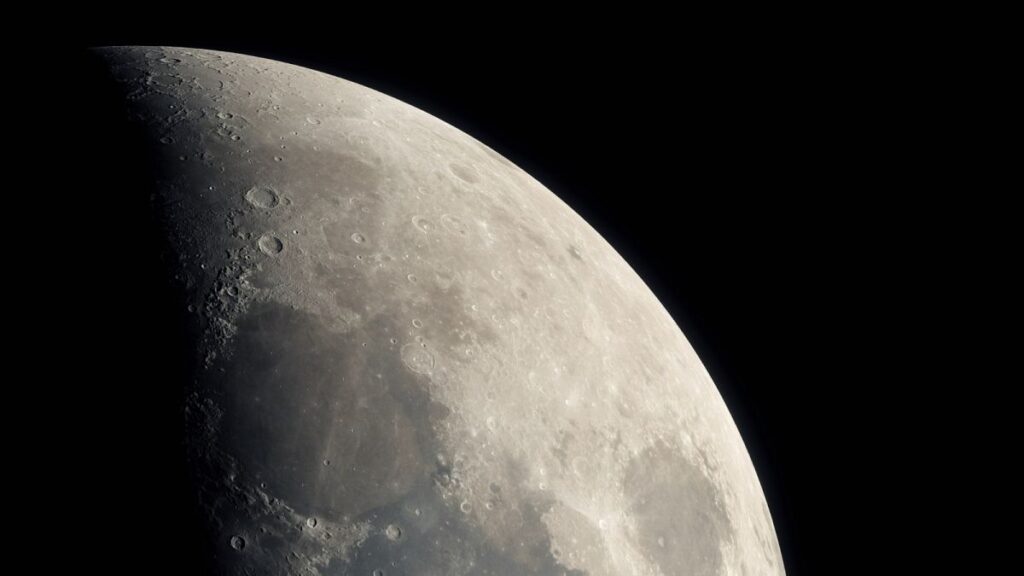Intuitive Machines’ successful lunar mission last month was partly subsidized by NASA – and that’s just the beginning.
Intuitive Machines’ successful moon landing last month will be the first in a series of attempts by private companies in the United States through the end of the decade.
The lunar mission was cut short after five days, due to a loss of energy from the lunar lander Odysseus, the sun having moved away from the last solar panel located at the rear of the device.
Joel Kearns, deputy associate administrator for exploration in NASA’s Science Mission Directorate, said at a press conference a few days after the mission began: “We can consider this mission as a flight test”.
Indeed, the Intuitive Machines project was partly funded by a relatively new and little-known NASA program, the Commercial Lunar Payload Services (CLPS) initiative. His goal : entrust for the first time the responsibility and technical aspects of a moon landing to private companies.
Nicholas Peter, president of the International Space University (ISU) in France, believes that this new NASA program marks the start of a “new race to the Moon” for the United States, which is trying to match the recent successful landings ofIndiaof Japan and some China.
“The (CLPS) program offers more opportunities to develop scientific missions to the Moon, now that it is no longer reserved for government agencies”explains Nicholas Peter to Euronews Next.
NASA’s new mission
On May 3, 2018, NASA released a new statement stating that exploration of the Moon’s surface would continue in the future, but in a different way.
In the process, the American agency announced an investment of 2.6 billion dollars (2.4 billion euros) until 2028 in permanent contracts, intended for a limited number of private companiesfor’“accelerate” the American return to the Moon.
“We will leverage the interests and capabilities of U.S. industry and our international partners to ensure American innovation returns astronauts to the Moon and destinations further afield in the solar system, including Mars.”declared Jim Bridenstine, NASA administrator, in a press release published at the time.
The Intuitive Machines spacecraft is the second to be launched as part of the CLPS program.
In January, Pittsburg-based Astrobotic Technology’s mission failed due to a propellant leak that prevented the craft from landing. Other NASA-funded companies, such as Draper and Firefly Aerospace, are working on upcoming missions.
Several of these are expected to take place later this year, including Astrobotic’s VIPER mission to the lunar south pole, a Firefly Aerospace technology delivery to a basalt plain on the Moon, and another mission to ‘Intuitive Machines towards Reiner Gamma, a lunar whirlwind.
NASA did not wish to answer questions from Euronews Next.
It’s no longer about planting a flag
Chris Boger, director of human spaceflight and exploration at Draper, says thatBefore NASA’s new CLPS program, it was rare for a private company space mission to be supported by the government.
The space agency instead entrusted private companies with the task of developing part of the spacecraft. Draper’s first contract with NASA was in 1959 and was for the development of the navigation system for the famous Apollo landing.
Recently, Chris Boger suggested that there had been a new “blast” of commercial interest in returning to the Moon. According to him, NASA is therefore encouraged to finance more missions and, by extension, to create a more promising space for start-ups.
There are other reasons to want to return to the Moon, according to Nicholas Peter of the International Space University, including deep space data storage.
It is also about establishing a new frontier forresource extraction. The Moon has abundant water and hydrogen, which Nicholas Peter says will become increasingly important on Earth.
“Space exploration is no longer about planting a flag”he adds, referring to the objectives of the 1969 moon landing.
A relay, not a sprint to the Moon
Draper’s 2025 mission will target the Schrodinger Basin, a region on the Moon that shows recent volcanic activity.
Chris Boger said he was “very happy” for his colleagues at Intuitive Machines when he heard the news of their soft landing.
He maintains that This modern space race is less of a sprint and more of a relay, requiring a lot of collaboration between all the companies leading the launches.
“It’s a close-knit community, there is a lot of transparency and sharing of information that we can take into account in the objectives of each mission”he concludes.


